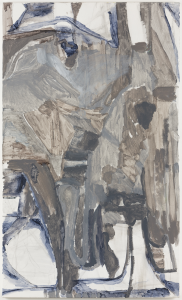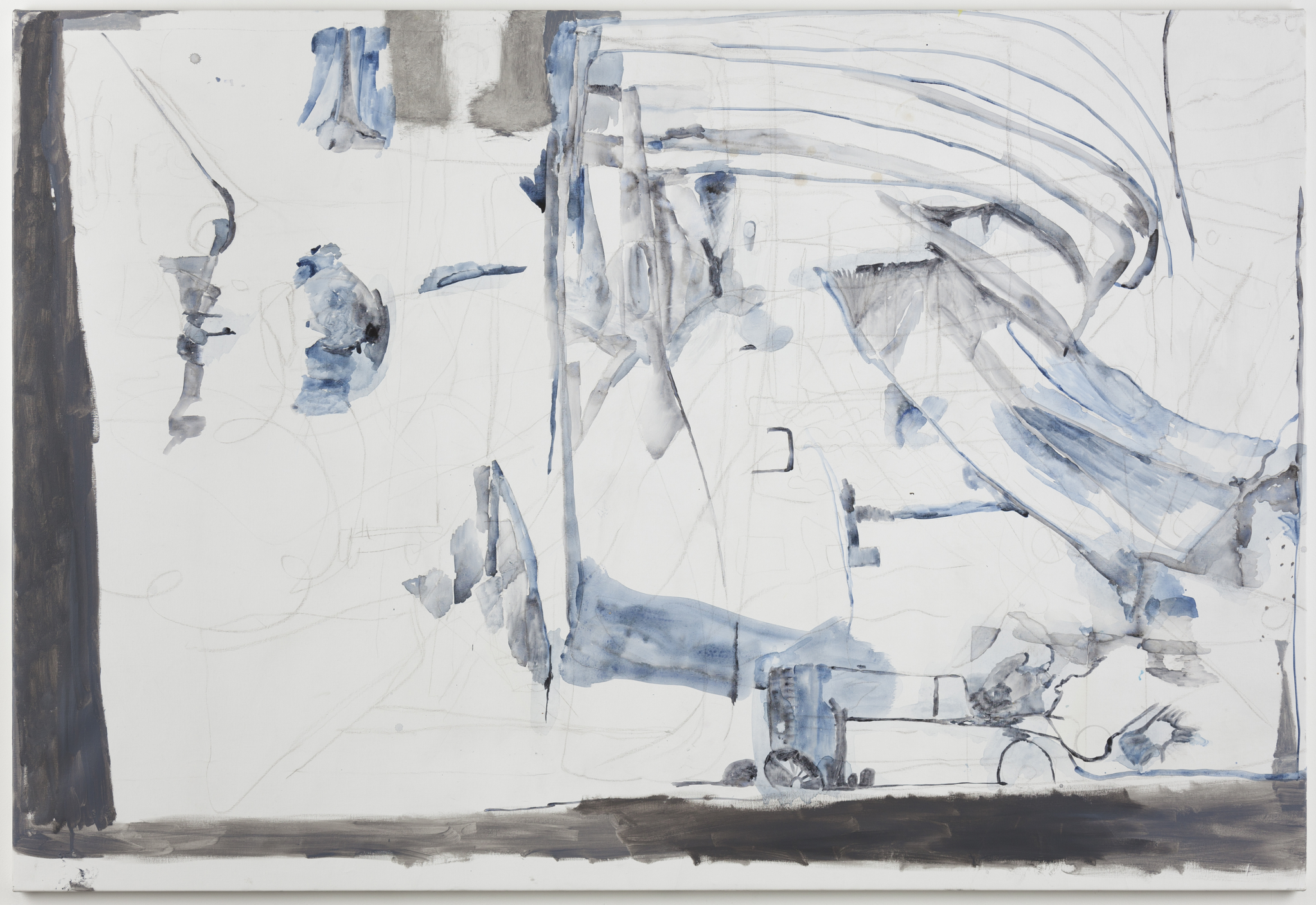As shown by the latest exhibition at the Renaissance Society by Buenos Aires-born and London-based painter Varda Caivano, abstract art still very much has an audience. At the opening of the exhibit last week, entitled “The Density of the Actions,” the patrons were noticeably confounded, enchanted, and unsettled by art on display. And not without cause—her paintings are imaginatively filled with colors, lines, and forms that are both intricately incoherent and effortlessly comprehensive.
The exhibition consists of seven large paintings, all of which are untitled and spread out, mounted across from one another on two long walls. Caivano’s use of grey and charcoal is front and center in the series, each piece creating a different sense of both time and space through the shadowy gradients. The juxtaposed lines and forms are reminiscent of strange landscapes, manmade and natural alike—yet they never decisively emphasize one mood or tone over another.
The space also features two vitrines on either side of the gallery, each filled with numerous preliminary sketches, which Caivano refers to as “works on paper.” She declines to refer to them as drafts as she does not consider them in any way inferior to her later work.
The space was designed in collaboration with architect Peter St. John and is arranged to mimic a sort of ongoing dialogue between the pieces.
“There is a conversation between the work in how [the paintings] resonate with and contrast each other to the point where it feels like all of the paintings are only one work,” Caivano says.
For the show, she points towards both the color grey and charcoal as two of her most recent inspirations. After showing at the International Art Exhibition at the Venice Biennale in 2013 and starting a six-month long scholarship in Rome, Caivano began seriously experimenting with the two elements hoping to be more specific in her intentions and to “reduce the number of possibilities,” simultaneously striking a contrast to the vibrant, colorful works she had been working on previously.

The impulse to see something tangible in Caivano’s work reflects the inherent desire of a viewer to make sense of the abstraction presented before them. Yet Caivano does not consider such an undertaking—which could be mistaken by other artists as an unfortunate side effect of the style itself—as inferior to any other type of experience one has when viewing her work.
“My purpose is not to guide the eye of the viewer to see this or that, to make them consume the work as a commodity…it’s much more to have an experience, a visual experience that people find interesting to look at, or uncomfortable as well,” she said when I spoke to her a few days before the opening of the gallery.
The priority placed upon the visual experience Caivano hopes to afford to the audience reflects her experience painting. She works on many pieces at the same time, returning time and time again to the same canvases in her studio—adding, taking away, and unapologetically manipulating.
“The image you see at the end is very much something that comes from the back to the top. There are paintings that are behind the paintings; it has to do with this idea of mental mapping,” Caivano says. These mental maps are front and center in the exhibition, where the physical techniques create an image that looks like it has endured numerous revisions without trying to make a polished product for consumption.
“It has to do with the idea of the memory of the image and of the fabric of the canvas itself: you might do something and then you might erase it, but it’s still kind of there. It’s something that you revisit in a different way,” she says.
Caivano’s growing success in the international art scene begs the question of the role of exposure in her relationship with her own work.
“If I am making the painting, I am not the one who is also going to be judging the painting. The viewer has their own experience with my work, and I have my own,” Caivano says.
She says she tries to step back from her role as viewer as much as she can, and that this act ultimately changes the path of the painting when returning to her role as artist. Above all else, her work and work ethic represent a drive to practice more, to research more, to explore more, and to eventually understand more about abstract art.
When asked if she ever reaches a place of satisfaction within her work, she does not answer definitively.
“If somehow you find yourself in a very well-known territory, a bit lost, it’s a really good sign because it means you can go somewhere new…I would say to stay curious is the most important thing.”
The Renaissance Society, 5811 S. Ellis Ave. Through April 19. Tuesday-Friday, 10am-5pm; Saturday-Sunday, noon-5pm. Free.(773)702-8670. renaissancesociety.org
Correction March 6, 2015: An earlier version of this article misspelled the name of Varda Caivano in a photo credit as “Vanda Caivano.”

